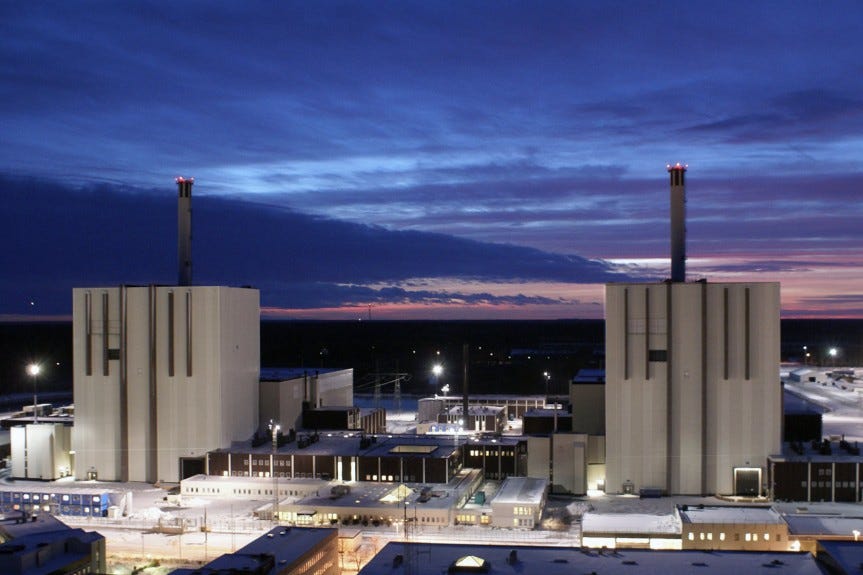"Diesel-Driven: Electric Car Charging Stations Powered by Giant Banks of Diesel Generators"
"While wind and solar advocates reckon we’ll all soon be driving electric vehicles charged up using sunshine and breezes, it’s ‘dirty’ old diesel that’s doing all the hard work."
The hypocrisy of the faux green agenda never ceases to amaze.
The following is a reposting of another great article published by Stop These Things today, 19 October 2023.
Since this post is too long for email, please click on the title to read on Substack.
Diesel-Driven: Electric Car Charging Stations Powered by Giant Banks of Diesel Generators
While wind and solar advocates reckon we’ll all soon be driving electric vehicles charged up using sunshine and breezes, it’s ‘dirty’ old diesel that’s doing all the hard work.
In Australia, those seemingly virtuous souls with EVs are really being propelled by coal, because 85% of the electricity passing through its Eastern grid comes from coal-fired plants. It’s an irony, to be sure.
In the first article, the team from Jo Nova identify yet another irony: a new EV battery factory in Kansas won’t be powered by wind and solar, after all. Instead, it’s power needs will be satisfied by ever-reliable coal-fired power.
In the second article, Charles Rotter reports on the world’s largest EV charging station which will, in the mother of all ironies, be run entirely using diesel generators. [Note to Ed: wasn’t the entire point to get away from using ‘dirty, evil fossil fuels’?]
In the third article, Eric Worrall notes the retreat by Microsoft from its earlier wind and solar push, as Bill Gates turns to the obvious source of his mega-software outfit’s power needs: nuclear.
New EV Battery factory in Kansas needs a coal plant to run
Jo Nova Blog
Jo Nova
29 September 2023For some reason wind and solar power will not be powering a new EV battery factory in Kansas. Instead the sudden extra demand for electricity will be met by keeping an old coal-fired plant running.
Environmentalists are not happy. Wait ’til they realize no one even knows if EV’s will reduce carbon dioxide at all.
EV Battery Factory Will Require So Much Energy It Needs A Coal Plant To Power It
Kevon Killough, Cowboy State Daily
A $4 billion Panasonic electric vehicle battery factory in De Soto, Kansas, will help satisfy the Biden administration’s efforts to get everyone into an EV. It also will help extend the life of a coal-fired power plant.
The Kansas City Star reports that the factory will require between 200 and 250 megawatts of electricity to operate. That’s roughly the amount of power needed for a small city.
Naturally, to make something utterly pointless takes a lot of taxpayer money and Panasonic will receive $6.8 billion from the Inflation Reduction Act, which will, quite possibly, increase emissions and create inflation too.
As Mark Mills said it takes 250 tons of material to make one EV. All that energy has to come from somewhere:
To match the energy stored in one pound of oil requires 15 pounds of lithium battery, which in turn entails digging up about 7,000 pounds of rock and dirt to get the minerals needed—lithium, graphite, copper, nickel, aluminum, zinc, neodymium, manganese, and so on. Thus, fabricating a typical, single half-ton EV battery requires mining and processing about 250 tons of materials.
It was all foreseeable. Europe, with more renewable energy, lost most factories for solar panels years ago, and is in the process of losing wind, batteries and EV’s. This week, Volkswagen cut EV production in Germany as demand “craters”.
Jo Nova BlogThe Irony of “Green” Charging Stations: The Harris Ranch Tesla Supercharger Station
By Charles Rotter • Watts Up With That?Touted as the world’s largest charging station with a whopping 98 charging bays, one would expect this facility to be the epitome of green energy. After all, back in 2017, Tesla’s CEO Elon Musk proudly declared that all Superchargers in the automaker’s network were transitioning to solar.
“Over time, almost all will disconnect from the electricity grid,” he confidently posted on X, formerly known as Twitter.
But as it turns out, the reality is quite different.
“Superchargers charge vehicles up to the 80% sweet spot in as little as 20 minutes, but to provide that kind of power for nearly 100 bays takes something solar can’t provide — diesel generators.”
That’s right. Diesel generators. The very antithesis of the clean, green energy that Tesla and other electric vehicle (EV) proponents have been preaching about. Investigative journalist Edward Niedermeyer made the startling discovery that these diesel generators were conveniently tucked away behind a Shell station. And when reporters from SF Gate tried to ascertain just how much of the station’s electricity came from these generators, Tesla remained conspicuously silent.
“The station isn’t connected to any dedicated solar farms, which means that absent the diesel generators, the station is powered by California’s grid.”
Now, let’s take a moment to ponder the implications of this. According to the U.S. Energy and Information Administration, as of June 2023, natural gas supplied nearly 5,000 megawatt hours of electricity in California, while non-hydroelectric renewables provided about 7,250 megawatt hours. So, even if we give Tesla the benefit of the doubt and assume that the Supercharger station occasionally draws power from the grid, it’s still not entirely “green.”
But wait, there’s more. Energy analyst David Blackmon, author of “Energy Transition Absurdities,” points out that the Harris Ranch station isn’t an isolated case. He recalls a Whole Foods in Houston that had installed a charging station, which, to his amusement, took up prime parking real estate and even displaced several handicap spaces.
“He said there were diesel generators behind the store and whenever someone was using the chargers, the generators would kick in.”
It’s almost comical, isn’t it? The very establishments that tout their commitment to sustainability and a cleaner future are, in reality, relying on the same “dirty” energy sources they publicly condemn.
Blackmon further highlights the lack of foresight in the current energy transition, especially as the demand for EVs grows. The retirement of a coal-fired power plant in Kansas had to be postponed to cater to the energy needs of an under-construction EV battery factory. As Blackmon aptly puts it:
“These stories illustrate well the lack of thought going into the demands that will be placed on the grid with increasing amounts of electric vehicle adoption.”
State Sen. Cheri Steinmetz, R-Lingle, echoes this sentiment, emphasizing the unreliability of wind and solar energy to meet the growing energy demands.
“Adding the load required for electric vehicles and the transportation network to support them would exacerbate the looming shortages we already face in the near future if energy policies are not reformed,” Steinmetz warns.
Blackmon also sheds light on the impracticality of Musk’s vision to power charging stations solely with solar energy.
“If that’s what he wants, then he only wants the chargers to work six to eight hours a day. If they’re purely powered by solar, there’s just no way out of that,” Blackmon states.
Musk’s ambitious claims have often been met with skepticism. From promises of powering the world with a small patch of the Sahara Desert to the assertion that Superchargers would disconnect from the grid, many of these pledges remain unfulfilled. Energy expert Alex Epstein even debunked Musk’s Sahara claim, estimating that the cost of creating a reliable grid using batteries would be a staggering $590 trillion, excluding transmission infrastructure costs. And let’s not forget that these batteries have a lifespan of a mere decade.
In conclusion, the Harris Ranch Tesla Supercharger station serves as a stark reminder of the challenges and contradictions inherent in the current energy transition narrative. The current execution of the so-called energy transition leaves much to be desired. We need to approach the energy policy with realism, acknowledging the limitations of current technologies and the indispensable role of traditional energy sources.
“Actions speak louder than words.” And in this case, the diesel generators behind the world’s largest charging station are speaking volumes.
Watts Up With That?Renewable Energy? Microsoft Advertises for a Nuclear Data Center Project Leader
By Eric Worrall • 1 October 2023 • Watts Up With That?Microsoft appears to have quietly accepted the reality that renewables cannot deliver the reliable and affordable energy their data centers need.
Principal Program Manager Nuclear Technology
Multiple Locations, United States
Date posted Sep 25, 2023
Job number 1627555
Work site Up to 100% work from home
Travel 0-25 %
Role type Individual Contributor
Profession Program Management
Discipline Technical Program Management
Employment type Full-TimeOverview
“The next major wave of computing is being born, as the Microsoft Cloud turns the world’s most advanced AI models into a new computing platform,” said Satya Nadella, chairman and chief executive officer of Microsoft. “We are committed to helping our customers use our platforms and tools to do more with less today and innovate for the future in the new era of AI.”We’re looking for a Principal Program Manager, Nuclear Technology, who will be responsible for maturing and implementing a global Small Modular Reactor (SMR) and microreactor energy strategy.
This senior position is tasked with leading the technical assessment for the integration of SMR and microreactors to power the datacenters that the Microsoft Cloud and AI reside on. They will maintain a clear and adaptable roadmap for the technology’sintegration, diligently select and manage technology partners and solutions, and constantly evaluate the business implications of progress and implementation.
Before you rush to brush up your CV, the job mentions they are no longer accepting applications.
Microsoft also inked a deal in June with Constellation Energy to supply nuclear power to one of their data centres.
Microsoft tried the renewable route, but it obviously isn’t working out.
Back in 2015 Bill Gates announced a $1 billion investment in clean energy. But by 2018 he had cooled somewhat on renewables over concerns battery technology wasn’t up to the job of firming intermittent energy sources, though he still seems to be slinging lots of cash at exotic energy projects, such as organic solar cell development.
As far as I’m aware Bill Gates and Microsoft have not made an official comment on why they need a nuclear programme. Which seems rather a shame, because a strong statement from someone as well known as Bill Gates could potentially help save the world from squandering trillions of dollars on useless renewables.
Related posts:











We know that they are lying, hypocritical, bastards.
We just need to convince the rest of the world that they are being deceived.
Again.